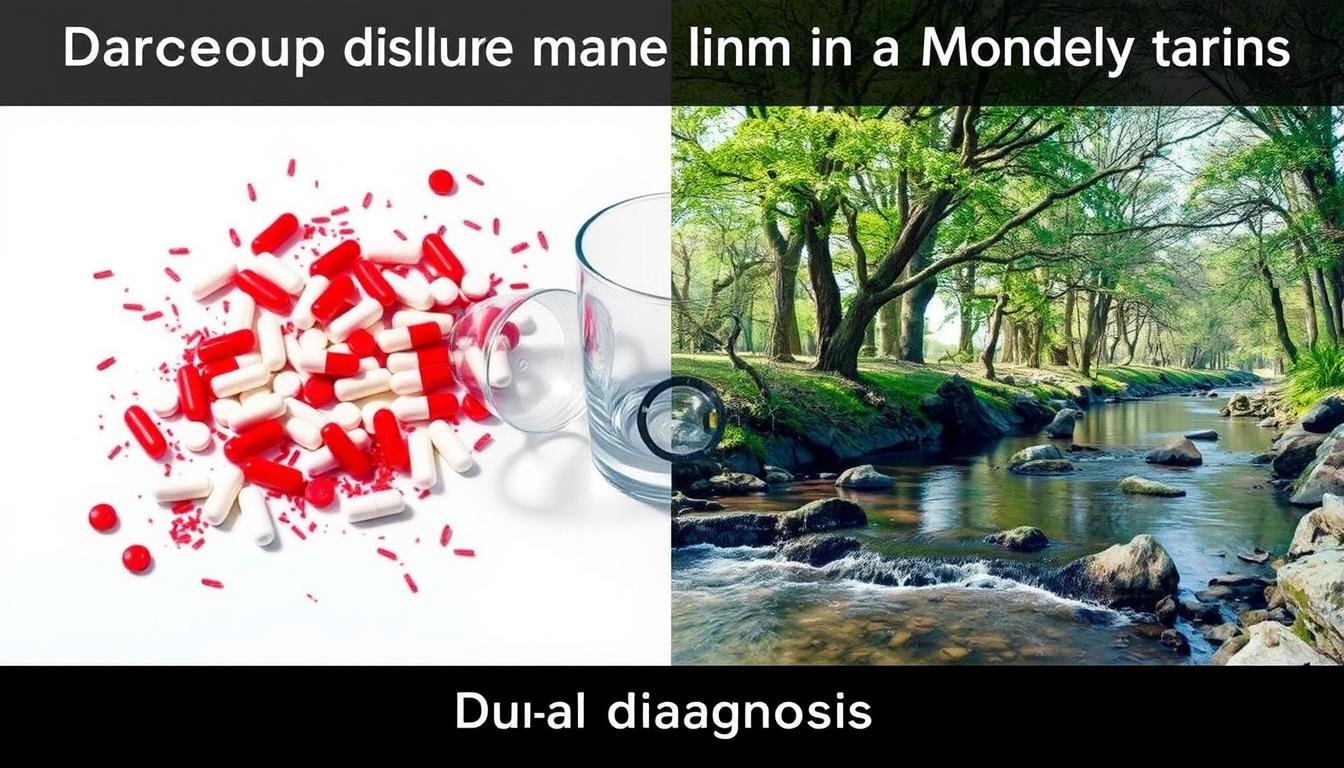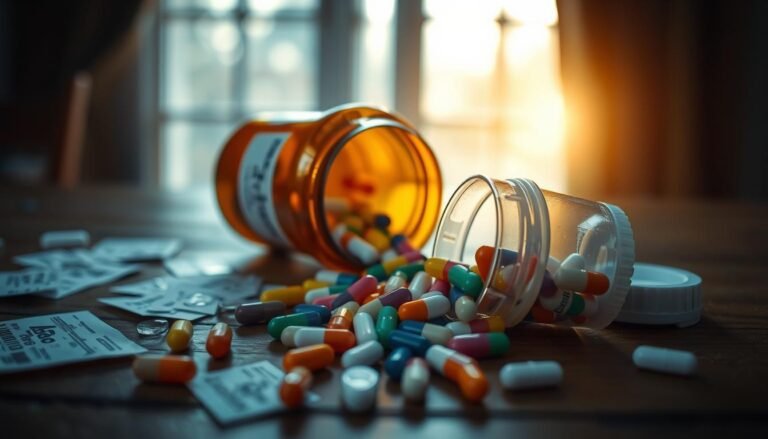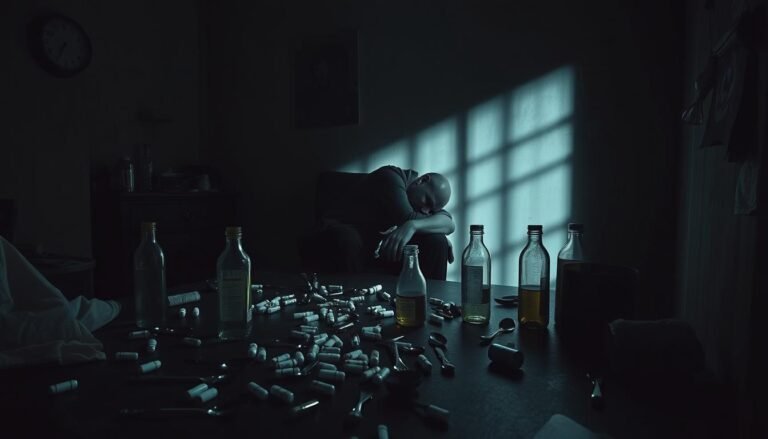Dual Diagnosis in Prescription Drug Addiction: Understanding the Complexity
A big number, 22%, of people in addiction treatment have both mental health and substance use issues. This shows how important dual diagnosis is in the U.S. It’s key to understand how mental health and addiction work together. This helps in treating dual diagnosis well.
For the latest on dual diagnosis, check out addictionhotlinetoday.com, habitrecovery.com, and rehabme.org.
About 7.9 million adults in the U.S. deal with both mental health and addiction problems. This shows many people face both issues at once. It’s important to treat both together, which is a big part of dual diagnosis treatment.
People with mental health issues are more likely to have addiction problems. This shows we need to care for both issues together. This is key for treating dual diagnosis in prescription drug addiction.
Key Takeaways
- Dual diagnosis in prescription drug addiction refers to the co-occurrence of a mental health disorder and a substance use disorder.
- Approximately 22% of patients in addiction treatment programs have co-occurring mental health and substance use disorders.
- Integrated treatment models are necessary to address both mental health and addiction concerns simultaneously.
- Comprehensive care approaches are essential to address the unique needs of individuals with co-occurring disorders.
- Dual diagnosis treatment incorporates various therapeutic options, including cognitive-behavioral therapy (CBT) and medication management.
What is Dual Diagnosis in Prescription Drug Addiction?
Dual diagnosis means having both a mental health issue and a substance use problem. This mix can make each problem worse. Studies show about 21.5 million adults in the U.S. have both serious mental illness and a substance use disorder.
People with dual diagnosis might act differently, feel mood swings, or struggle with daily tasks. Addiction and mental illness are hard to spot and treat because their signs are similar. Common mental health issues that go with substance abuse include depression, anxiety, bipolar disorder, and PTSD.
Treatment for dual diagnosis needs a mix of mental health and substance abuse therapies. This might include medicines, talk therapy, and support groups. It’s key to treat both problems at the same time to help someone get better and stay that way. With the right care, people can beat their co-occurring disorders and live a better life.
The Complex Relationship Between Mental Health and Addiction
About 50% of people with serious mental health issues also have addiction problems. This shows how closely mental health and addiction are linked. Both can affect each other. It’s important to treat both together for the best results.
Therapy for addiction can help people find better ways to deal with their feelings. It can also make them feel better overall. Some common mental health issues that go with addiction are depression, anxiety, bipolar disorder, and schizophrenia. Here are some numbers that show how common it is:
- 29% of people with mental illness also have addiction
- 37% of those with severe mental health issues have alcohol problems
- 53% of them have drug problems
Dealing with both issues at once is hard. It’s because of the complex symptoms and the risk of going back to old habits. But, with the right help, people can get better.
It’s important to keep getting support and staying on track. By treating both mental health and addiction together, people can get better. They can live a happier life.
| Mental Health Disorder | Prevalence of Substance Use Disorder |
|---|---|
| Depression | 21% |
| Anxiety | 17% |
| Bipolar Disorder | 34% |
| Schizophrenia | 41% |
Risk Factors for Developing Co-occurring Disorders
Co-occurring disorders mix mental health and substance abuse issues. Knowing what causes them helps in treating them. About 21.5 million adults in the U.S. face both mental illness and substance use disorders.
Genetic predisposition, environmental triggers, and trauma are big risk factors. Genetic predisposition can lead to mental health and addiction issues. Stress and trauma from the environment also play a part.
Key Risk Factors
- Genetic predisposition: Family history of mental health or substance abuse disorders raises the risk.
- Environmental triggers: Stress, trauma, and other factors can lead to co-occurring disorders.
- Trauma: Experiences like physical or emotional abuse increase the risk.
Treating co-occurring disorders needs to tackle these risk factors. Treating both mental health and substance abuse together improves care and outcomes.
Understanding these risk factors helps in preventing and treating co-occurring disorders. We must support those with these conditions, as well as their families and caregivers.
| Risk Factor | Description |
|---|---|
| Genetic Predisposition | Family history of mental health or substance abuse disorders |
| Environmental Triggers | Stress, trauma, and other environmental factors |
| Trauma | Traumatic experiences, such as physical or emotional abuse |
Signs and Symptoms of Dual Diagnosis
Dual diagnosis is when someone has a mental health issue and a substance problem. Severe mood swings, anxiety, depression, and substance abuse are signs of this. It’s important to get help, like dual diagnosis treatment and counseling, to tackle both problems.
According to SAMHSA, about 8.4% of people had both a mental illness and a substance use disorder in 2022. This shows we need treatments that cover both parts of dual diagnosis.
Some common signs and symptoms of dual diagnosis include:
- Severe mood swings
- Anxiety and depression
- Substance abuse
- Difficulty managing daily life
- Strained relationships
It’s key to find a professional who can help with dual diagnosis treatment and counseling.
| Condition | Signs and Symptoms | Treatment |
|---|---|---|
| Dual Diagnosis | Severe mood swings, anxiety, depression, substance abuse | Dual diagnosis treatment, prescription drug addiction counseling |
By recognizing the signs and symptoms of dual diagnosis and seeking professional help, individuals can get the treatment they need. This helps them manage their condition and work towards recovery.
The Challenge of Self-Medication and Prescription Drug Abuse
Self-medication and prescription drug abuse are big challenges in dual diagnosis. People might use drugs to deal with their mental health. Prescription drug addiction counseling is key to help them recover.
It’s important to spot self-medication and break the addiction cycle. Personalized treatment plans help meet each person’s needs. These plans might include therapy and managing medication.
Some drugs that can lead to addiction are:
- Opioids
- Benzodiazepines
- Stimulants
Getting a treatment plan from a healthcare pro is vital. It should fit the person’s specific situation.
With the right help, people can beat self-medication and drug abuse. They can manage their mental health and addiction. This improves their overall well-being.
| Prescription Drug | Common Uses | Risk of Addiction |
|---|---|---|
| Opioids | Pain management | High |
| Benzodiazepines | Anxiety and insomnia | Medium |
| Stimulants | ADHD and narcolepsy | High |
Understanding the Complexity of Dual Diagnosis Treatment
Dual diagnosis treatment needs a holistic approach. It looks at both mental health and addiction. This way, treatment covers all bases.
An integrated treatment approach works well. It includes therapy, counseling, and medicine. This mix helps manage dual diagnosis.
Some important parts of dual diagnosis treatment are:
- Cognitive Behavioral Therapy (CBT)
- Dialectical Behavior Therapy (DBT)
- Motivational Interviewing (MI)
- Trauma-Informed Care
- Family Therapy
These methods tackle different parts of the conditions. They offer full care. A holistic approach to dual diagnosis means getting care that fits you. This way, you get better and stay well.
An integrated treatment approach is key. It treats both mental health and addiction at the same time. This is how you get the best care.

Knowing about dual diagnosis treatment helps you recover better. The right care can help you live a healthier life. You can beat the challenges of dual diagnosis.
| Treatment Approach | Components | Benefits |
|---|---|---|
| Holistic Approach | Mental health therapy, addiction counseling, medication management | Comprehensive care, improved outcomes, reduced relapse and hospitalization risks |
| Integrated Treatment Approach | Cognitive Behavioral Therapy, Dialectical Behavior Therapy, Motivational Interviewing, Trauma-Informed Care, Family Therapy | Personalized care, improved outcomes, reduced relapse and hospitalization risks |
Integrated Treatment Approaches for Better Outcomes
An integrated treatment approach is key for those with dual diagnosis. It tackles both mental health and substance use disorders at once. This method leads to better results by giving a full and complete treatment plan.
Mental health therapy for addiction is a big part of this approach. It helps people find ways to cope and feel better overall.
Some important parts of this approach are:
- Medical management: This means getting a special medication plan that fits the person’s mental health and addiction.
- Therapeutic interventions: This includes one-on-one and group therapy. It helps people learn to cope and talk better.
- Support group integration: It gives people a community and support, which is key for getting better.
With an integrated treatment approach, people with dual diagnosis can see big improvements. It’s important to remember that each person’s treatment should fit their unique needs. An integrated approach offers the needed flexibility and fullness to meet these needs.
The Role of Family Support in Recovery
Family support is key in helping people with dual diagnosis treatment. It gives emotional support and encouragement. Family members help their loved ones manage their conditions and get better.
Studies show family therapy is vital in addiction recovery. It helps improve family communication and relationships. Family therapy in dual diagnosis treatment plans helps create a supportive environment for growth and recovery.
Family Education Programs
Family education programs teach family members about dual diagnosis and co-occurring disorders. This helps them support their loved ones better. These programs also help families set healthy boundaries and communicate better.
Creating Supportive Environments
A supportive environment is important for recovery. It makes people feel safe and secure. Family members can help by giving emotional support, practical help, and positive feedback.
Together, families can help their loved ones beat the challenges of dual diagnosis treatment. This way, they can achieve long-term recovery.

Good family support is very important in recovery. It’s key to have family education programs and supportive environments. This way, families can help their loved ones overcome co-occurring disorders and succeed in recovery.
Preventing Relapse in Dual Diagnosis Cases
Stopping relapse is key in dual diagnosis cases. Prescription drug addiction counseling helps people manage their addiction. Sadly, 94% of those with substance use disorders don’t get help.
Personalized treatment plans meet each person’s needs. They include integrated therapies like cognitive-behavioral therapy (CBT) and dialectical behavior therapy (DBT). Also, there’s medication management and support groups.
Some important parts of dual diagnosis treatment are:
- Comprehensive assessment and integrated treatment approaches
- Medical and psychiatric support
- Therapeutic modalities, such as individual and group therapy
- Support groups and relapse prevention strategies
Prescription drug addiction counseling and personalized treatment plans give people the tools to manage their addiction. This helps prevent relapse and supports long-term recovery.
| Treatment Approach | Benefits |
|---|---|
| Integrated therapies | Lower rates of relapse, higher rates of employment, and improved quality of life |
| Medication management | Effective management of symptoms and reduction of cravings |
| Support groups | Sense of community and connection, reduced feelings of isolation |
Building a Sustainable Recovery Plan
A good recovery plan is key for those with dual diagnosis. It helps manage both mental health and addiction. A holistic approach to dual diagnosis sees how mental health and addiction are linked. It helps create a lasting recovery plan.
An integrated treatment approach is vital for a good recovery plan. It mixes medical care, therapy, and support groups. This way, all parts of addiction and mental health are treated together.
Some important parts of a good recovery plan are:
- Long-term management strategies
- Lifestyle modifications
- Ongoing support resources
These parts help create a safe space for recovery. They let people work on both mental health and addiction at the same time.
Choosing a full and integrated treatment approach helps avoid relapse. It leads to better results. With the right help, people can live a better life.
| Component | Description |
|---|---|
| Long-term management strategies | Provide a structured environment for individuals to focus on recovery |
| Lifestyle modifications | Help individuals develop healthy habits and coping mechanisms |
| Ongoing support resources | Offer continued support and guidance throughout the recovery process |
Conclusion: Hope and Healing in Dual Diagnosis Recovery
Dual diagnosis recovery is tough but doable with the right help. About 45% of people with addiction also have a mental health issue. Almost 17 million adults in the US face both a mental health problem and addiction.
Substance abuse and mental health are closely tied. Treating one without the other doesn’t work. Dual diagnosis treatment includes medical care, therapy, and support groups. This way, people can manage their mental health and addiction.
With the right treatment, people can beat addiction and mental health issues. It’s key to keep hope alive and offer support. This helps those with co-occurring disorders to live a better life.






